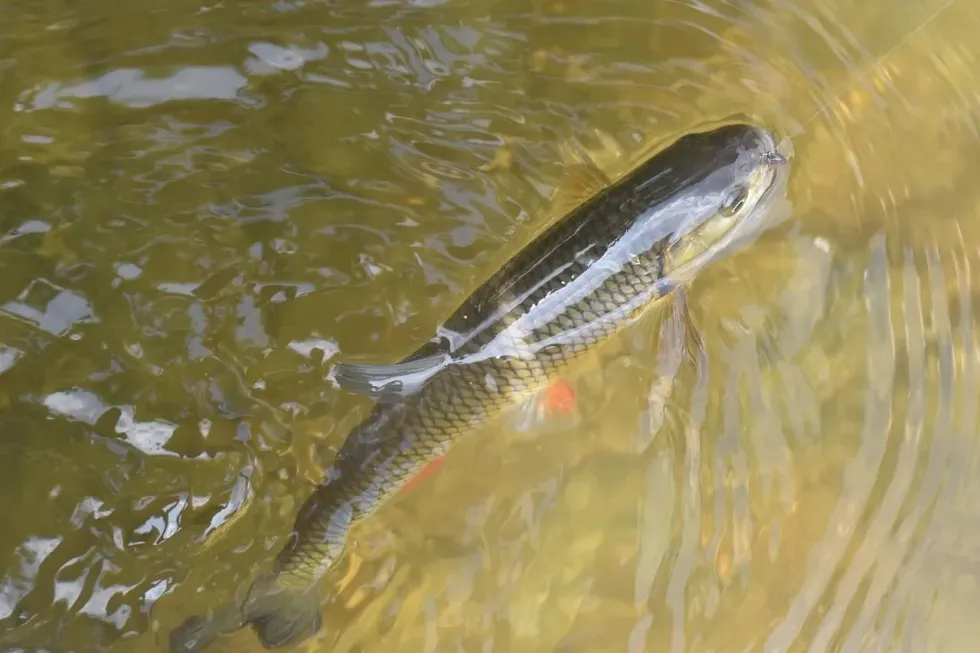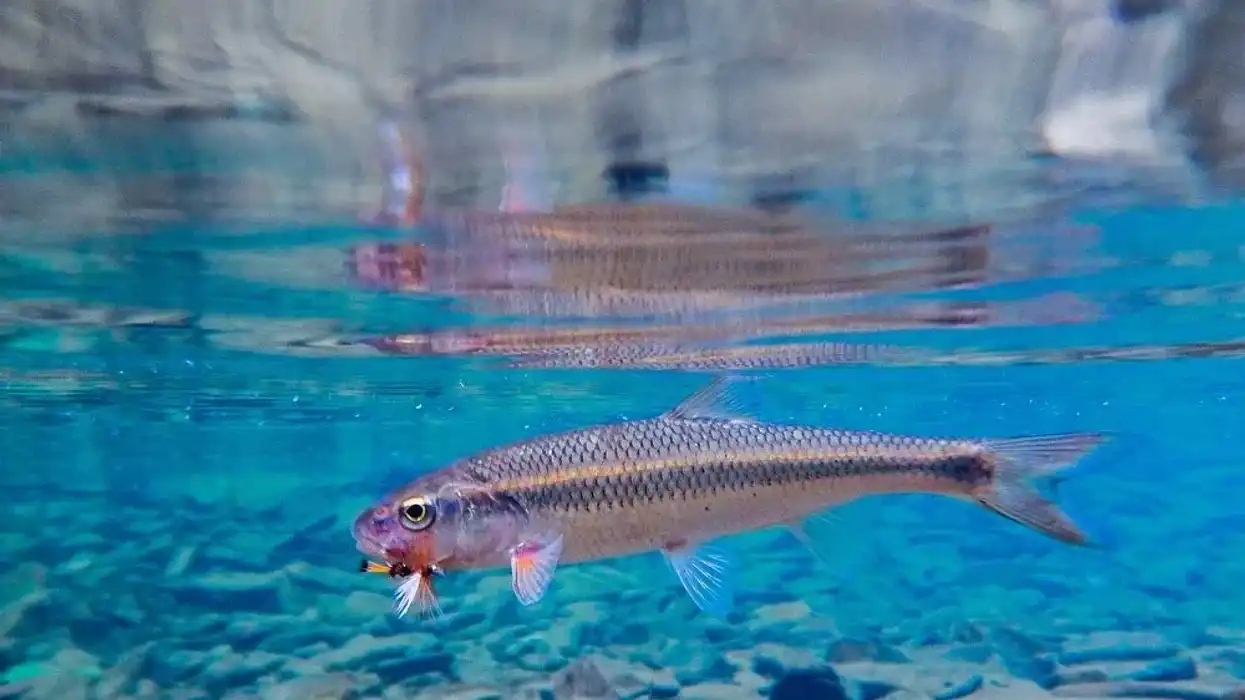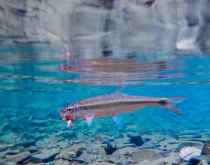Fun Fallfish Facts For Kids
Fallfish is a ray-finned fish from the minnow and the carp family. The scientific name of fallfish is Semotilus corporalis.
Fallfish were considered the apex predator before other fishes were introduced, such as bass and brook trout. They are freshwater fish native to the United States and eastern Canada, from Virginia to Ontario. They live in water areas such as the lake, streams, and small pools.
Interestingly, in this species of fish, breeding males start making their nests with the help of small pebbles and stones to attract female mates. The nest size is usually between 3-6 ft (36-72 in) in height and weighs approximately 200 lb (90.7 kg).
Spawning males are generally more active and protective toward their territories. The average litter size of fallfish is around 2000-3000 eggs per breeding season.
Young fallfish are also known as juvenile fallfish; they reach sexual maturity after three to four years. They have a dark stripe on their body which disappears after they gain maturity.
In the order of Cyprinidae, the fallfish lifespan is between three to eight years. They are listed as under Least Concern and face environmental issues such as water pollution and activities that increase turbidity.
If you like reading this article, then you must also have a read of Redtail catfish and Meagre fish facts.
Fallfish Interesting Facts
What type of animal is a fallfish?
Fallfish is a fish, also known as game fish, from the minnow species.
What class of animal does a fallfish belong to?
Fallfish is a part of the ray-finned fishes of the class Chub in order Cyprinidae family.
How many fallfish are there in the world?
An official study of their worldwide population has not been conducted. Fallfishes are found in the United States and eastern Canada, usually in the freshwater. There are approx 800 freshwater fish species in North America, and worldwide it is 10,000. These species live in the same water for years in lakes, ponds, and rivers.
Where does a fallfish live?
Fallfish (Semotilus corporalis) are found in northern American areas, usually from eastern Canada to the north of Virginia.
What is a fallfish's habitat?
They prefer habitats with moderate temperatures in freshwaters like ponds, rivers, streams, lakes, pools, or rarely in oceans. Fallfish habitat depends on their living lifestyle and diet. Fallfishes usually eat Chironomids, Zooplankton, fish eggs, and terrestrial insects, including eating bass and trout.
They live in forage in the watershed areas, usually 12-20 in (30-50 cm) deep. Male fallfish (Semotilus Corporalis) make nests with the help of stones and pebbles, generally in shallow areas.
They are known as game fish, and fallfish croaking is one of the unique traits for which they are known. Male fish can get very dark during the spawning season from the bottom.
Fallfishes are freshwater fishes that construct their own nest with the help of stones and pebbles, as fishermen usually catch them by using ultra-light tackle and live in the river, streams, lakes, and pools.
Who do fallfish live with?
Chubs are known to be solitary fish. Fallfish are from minnows and carps family usually found in water from the region of Canada to Virginia in rivers, lakes, and streams.
They usually come in a group during the breeding season. The young fallfish live with their parents, especially with females, until they become mature enough to protect themselves and their territory.
Fallfish live in the same river or within their region for years and cannot survive in muddy water. It is common to find many other species of fallfish in the same river or stream.
How long does a fallfish live?
The average life span of adult fallfish is around three to eight years, and their maximum life span has been known to be recorded at ten years. They are freshwater fish usually found in water areas and streams native to the U.S. and Canada, ranging from Virginia to Ontario.
According to several articles and reports, fallfish were considered the apex predators before other species were introduced into their natural habitat.
The typical main threats are turbidity increasing conditions, and water pollution. The fishermen also catch them to sell in the marketplaces.
How do they reproduce?
Fallfish fall under the category of polygamous breeders. The breeding males usually start collecting small pebbles and stones to construct a nest to attract a female mate and a place where females eventually lay eggs.
The nest is around six feet (1.8 m) tall and weighs approximately 200 lb (90.7 kg). Fallfish live in the same river for years. The male fallfish sometimes prefer taking over other nests created by other males to fertilize any eggs laid by another female.
This is commonly known as satellite behavior. Young adults show more satellite behavior than older ones.
Fallfish usually mate between March and June. The incubation period is between 139-144 hours to develop and hatch. The juveniles reach maturity at the age of three to four years, and when they achieve adulthood, the stripes on the body of the young fallfish disappear.
What is their conservation status?
According to the IUCN list, fallfish record indicates that they fall into the category of Least Concern. They are generally found in the wild, in freshwater. There is no record of the minnow or fallfish (Semotilus corporalis) ever being kept in captivity.
Fallfish Fun Facts
What do fallfish look like?
Fallfish is a North American fish that fall under the category of large fish species that live in the same river or streams for years. The adult fallfish size is around 6-16 in (15.5-43 cm) long and weighs about 1-3 lb (720-800 g).
They have large eyes with smooth and rounded heads due to the lack of scales on their body. Fallfish are usually black, brown, and olive green with a forked tail containing 19 bony rays with whitish scales under their bellies.
It is observed that minnows, during spawning, tubercles appear on their heads, concentrated around their eyes and near their noses. Juvenile fallfish are identified by observing their dark stripe body, which usually disappears when they reach sexual maturity. They are also more active than their adult counterparts.

*Please note that the image is of a chub fish and not fallfish. If you have an image of Fallfish, please contact us at kidadl.com
How cute are they?
Fallfish are not very cute with comparatively large sizes and unattractive bodies when compared to much more colorful and eye-catching aquarium fish.
How do they communicate?
Fallfish follow tactile and chemical methods as perception channels. They usually communicate by using chemical signals known as pheromones, which are released using its body.
They are found in streams, lakes, ponds, and rivers. Minnow sends the signals using pheromones which travel through a medium generally through water and are received by specific aquatic life. The pheromones are used for many correlated activities of fallfish species such as shoaling, homing migrating fish, alarm mechanisms, crowding controls, and spawning.
During the breeding season, fallfish males as part of their spawning behavior, release pheromones to attract a female mate to the nest. They are nocturnal and construct their own nest to keep them safe from fishers who catch them using ultra-light tackle.
How big is a fallfish?
Fallfish are large-sized freshwater fish, and they are the largest of the minnow fish. Fallfish grow up to around 6-16 in (15.5-43 cm) long.
If we compare fallfish vs creek chub, fallfish is two to three times bigger than creek chub. Creek chubs are 10-12 in (25-30 cm) and weigh around 0.7 lb (340 g). Shiner fallfish from the same order Cyprinidae found in North America is 3.0-4.9 in (7.5-12.5 cm) long.
How fast can a fallfish swim?
There is no official record of how fast fallfish can swim. They usually live under watershed areas that are around 12-20 in (30-50 cm) deep. Fallfish live in rivers, lakes, ponds, and fallfish tanks.
How much does a fallfish weigh?
The average weight of fallfish species is between 1-3 lb (720-800 g). Fallfish fall on the scales of fish having a medium-sized body. They are omnivores and depend on animals and plants for feeding. Fallfish are usually found in rivers, lakes, ponds, and streams and construct their own nest to live safely from their predators.
What are the male and female names of the species?
Fallfish do not have gender-specific names. They can be distinguished by their size as females usually grow larger than males in comparison. Minnows are solitary fishes that usually live in rivers, ponds, and lakes that construct their own nest to keep them safe from predators.
What would you call a baby fallfish?
The baby fallfish is known as juvenile fallfish or young fallfish. Young fallfish require around three to four years to reach sexual maturity and are ready to protect themselves and their territories.
The female fallfish lays eggs in their particular nest, and the quality of the nest is comparatively good and safe, made up of small stones and pebbles to keep fallfish and their young ones safe.
What do they eat?
Fallfishes are devious feeders and fall under the category of omnivores. They usually have a habit of eating a quality diet that includes plankton, aquatic and terrestrial insects, insect larvae, small crustaceans, fish, fish larvae, sponges, and algae.
Most of the cyprinid species eat algae as a staple food. The animal food they are dependent on includes fish eggs, insects, terrestrial non, insect arthropods, mollusks, aquatic or marine worms, aquatic crustaceans, and phytoplankton.
Fallfish are nocturnal fish which means that they hunt or are more active at night. Fallfish eating habits do not affect wildlife, and they are harmless to the ecosystem.
They have a medium-sized body which usually doesn't require a heavy diet. Fallfishes are northern American fish that are in competition with bass and trout fish for being the apex predator within their habitat.
Are they aggressive?
Fallfish (Semotilus corporalis), being part of the minnows, are not aggressive fish as they are not dangerous to human beings and as well as to other wildlife. They don't affect other species living in the same water. They are known to be good quality fish used for many purposes, such as making flavors and preservatives for food.
Would they make a good pet?
They can be kept as pets if you provide the right environment and diet for these fish in their Fallfish tanks. Fallfish species are found in Canada and areas of Virginia.
Many questions arise, including diet, adaptability, groups, and more. For fallfish to lead an ideal life, they must be within the fallfish range where the conditions are apt, such as proper water level, food availability, water temperature, and reproductive mates.
Did you know...
The largest world record fallfish is recorded in the year 2009 in April by Jonathan McNamara. The IGFA All-Tackle caught the world's largest fall fish in the Susquehanna River near Owego, New York, USA. The weight of the fish was recorded to be around 3 lb (1.3 kg).
Fallfish has a reputation for tasting bad, but contrary to popular belief, fallfish can be a tasty treat if you follow the right recipe. And depending on the preparation, they can taste sweet and tender, or bland.
What is fallfish considered to be?
Fallfish is the largest minnow species native to northeastern America, a chub in the order of Cyprinidae. They are basically from the genus Semotilus of Chordata phylum.
What did fallfish use to be?
Fallfish was the apex predator found in streams, lakes, and rivers before the introduction of bass fish and trout. The most common use of fallfish is that they play the bait role for anglers to catch larger fish.
Fallfish species are edible in many different ways and forms of other dishes. There are many cultures in which they are used as flavors and preservatives for food items. Many researchers are still finding new techniques and use for fallfish.
Here at Kidadl, we have carefully created lots of interesting family-friendly animal facts for everyone to discover! Learn more about some other fish, including Pilchard Facts or Plaice Facts.
You can even occupy yourself at home by coloring in one of our free printable fallfish coloring pages.
We Want Your Photos!
More for You
See All
Bachelor of Commerce specializing in Accounting and Finance, Master of Business Administration

Divya RaghavBachelor of Commerce specializing in Accounting and Finance, Master of Business Administration
With a diverse range of experience in finance, administration, and operations, Divya is a diligent worker known for her attention to detail. Born and raised in Bangalore, she completed her Bachelor's in Commerce from Christ University and is now pursuing an MBA at Narsee Monjee Institute of Management Studies, Bangalore. Along with her professional pursuits, Divya has a passion for baking, dancing, and writing content. She is also an avid animal lover who dedicates her time to volunteering for animal welfare causes.
Disclaimer
1) Kidadl is independent and to make our service free to you the reader we are supported by advertising. We hope you love our recommendations for products and services! What we suggest is selected independently by the Kidadl team. If you purchase using the Buy Now button we may earn a small commission. This does not influence our choices. Prices are correct and items are available at the time the article was published but we cannot guarantee that on the time of reading. Please note that Kidadl is a participant in the Amazon Services LLC Associates Program, an affiliate advertising program designed to provide a means for sites to earn advertising fees by advertising and linking to Amazon. We also link to other websites, but are not responsible for their content.
2) At Kidadl, we strive to recommend the very best activities and events. We will always aim to give you accurate information at the date of publication - however, information does change, so it’s important you do your own research, double-check and make the decision that is right for your family. We recognise that not all activities and ideas are appropriate for all children and families or in all circumstances. Our recommended activities are based on age but these are a guide. We recommend that these ideas are used as inspiration, that ideas are undertaken with appropriate adult supervision, and that each adult uses their own discretion and knowledge of their children to consider the safety and suitability. Kidadl cannot accept liability for the execution of these ideas, and parental supervision is advised at all times, as safety is paramount. Anyone using the information provided by Kidadl does so at their own risk and we can not accept liability if things go wrong.
3) Because we are an educational resource, we have quotes and facts about a range of historical and modern figures. We do not endorse the actions of or rhetoric of all the people included in these collections, but we think they are important for growing minds to learn about under the guidance of parents or guardians.







